Falcom SAMBA3G-G UMTS/GSM-Stick User Manual Application Note FOX3 3G ELA Active RFID Reader
Falcom GmbH UMTS/GSM-Stick Application Note FOX3 3G ELA Active RFID Reader
Falcom >
QIXSAMBA3G-G_UserMan
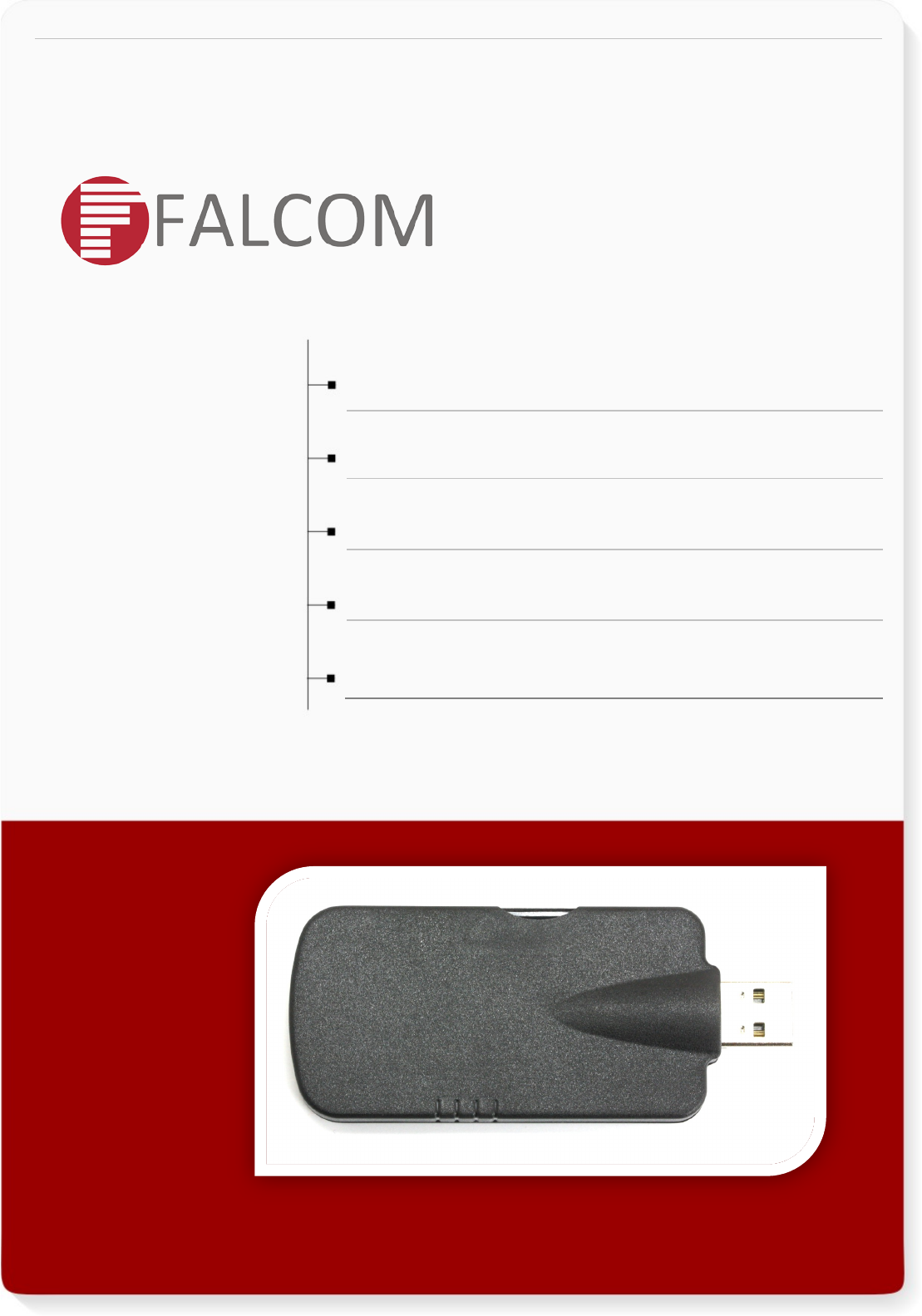
THIS DOCUMENT IS AVAILABLE AT HTTP://WWW.FALCOM.DE/
Version: 1.0.3; Modified: Tuesday, May 15, 2018
SAMBA3G-G
HSPA+ and quad-band GSM/EDGE data
transmission USB modem
Preliminary

SAMBA3G-G Version 1.0.3
This confidential document is a property of FALCOM GmbH and may not be copied or circulated without previous permission.
Page 2 of 22
Table of contents
1 Introduction ............................................................................................................ 5
1.1 General ................................................................................................................................... 5
1.2 AT command support ............................................................................................................. 5
1.3 Packaging ............................................................................................................................... 6
1.4 Labelling ................................................................................................................................. 6
1.5 Used abbreviations ................................................................................................................ 6
1.6 Related documents ................................................................................................................ 7
2 Security ................................................................................................................... 8
2.1 General information ............................................................................................................... 8
2.2 Exposure to RF energy ........................................................................................................... 8
2.3 Driving .................................................................................................................................... 8
2.4 Electronic devices .................................................................................................................. 8
2.5 Vehicle electronic equipment ................................................................................................ 9
2.6 Medical electronic equipment ............................................................................................... 9
2.7 Aircraft ................................................................................................................................... 9
2.8 Children .................................................................................................................................. 9
2.9 Blasting areas ......................................................................................................................... 9
2.10 Potentially explosive atmospheres ........................................................................................ 9
2.11 Non-ionizing radiation ......................................................................................................... 10
3 Safety standards ....................................................................................................11
4 Technical data ........................................................................................................12
4.1 Product specifications .......................................................................................................... 12
5 Interfaces in overview ............................................................................................14
5.1 4pin USB Type A connector .................................................................................................. 14
5.2 SIM-Card Reader .................................................................................................................. 15
6 System Requirements ............................................................................................16
6.1 Hardware & software requirements .................................................................................... 16
6.2 Setting up the modem ......................................................................................................... 16
6.2.1 Serial communication with SAMBA3G-G ........................................................................ 16
6.2.2 Inserting the SIM card: .................................................................................................... 16
6.2.3 Setup HyperTerminal program ........................................................................................ 17
6.2.4 Connecting Internet ......................................................................................................... 18
7 HOUSING ..................................................................................................................19
8 RF Exposures .....................................................................................................20
8.1 FCC and IC Statement (USA and Canada) - English .............................................................. 20
8.2 Déclaration FCC et IC (USA at Canada) - French .................................................................. 21

SAMBA3G-G Version 1.0.3
This confidential document is a property of FALCOM GmbH and may not be copied or circulated without previous permission.
Page 3 of 22
Version history:
This table provides a summary of the document revisions.
Version Author Changes Modified
1.0.3 F. Beqiri - Updated FCC and IC Statement for USA and Canada 15/05/2018
1.0.2 F. Beqiri - Added IC Statement for Canada 19/04/2018
1.0.1 F. Beqiri - Images throughout the document updated 06/02/2018
1.0.0 F. Beqiri - Initial version 22/11/2017

SAMBA3G-G Version 1.0.3
This confidential document is a property of FALCOM GmbH and may not be copied or circulated without previous permission.
Page 4 of 22
Cautions
The information furnished herein by FALCOM is believed to be accurate and reliable. However,
no responsibility is assumed for its use. Please, read carefully the safety precautions.
If you have any technical questions regarding this document or the product described in it, please
contact your vendor.
General information about FALCOM and its range of products are available at the following
Internet address: http://www.falcom.de/
Trademarks
Some mentioned products are registered trademarks of their respective companies.
Copyright
This document is copyrighted by FALCOM GmbH with all rights reserved. No part of this
documentation may be reproduced in any form without the prior written permission of FALCOM
GmbH.
FALCOM GmbH
No liability (incl. patent liability) is assumed with respect to the use of the information contained
herein.
Note
Because our products are being continuously improved, specifications and information given in
this document are subject to change by FALCOM without notice.

SAMBA3G-G Version 1.0.3
This confidential document is a property of FALCOM GmbH and may not be copied or circulated without previous permission.
Page 5 of 22
1INTRODUCTION
This manual is focussed on the GSM/GPRS/EDGE/UMTS data solutions of the enhanced
performance SAMBA3G-G USB modem from FALCOM GmbH.
1.1 General
SAMBA3G-G is a 3.75G modem providing up to six-band HSPA+ and quad-band GSM/EDGE data
transmission in a compact form factor. The 3G USB modem establishes a wireless connection to
the Internet by means of mobile radio technology and thus enables the communication between
the connected device and the Internet service. This modem features data-rates of up to 7.2 Mb/s
DL (downlink), a rich set of internet protocols, a single-band 2100MHz UMTS/HSDPA radio for data
connectivity and extended operating temperature range. It is ideally suited to industrial M2M
(Machine to Machine) applications. The SAMBA3G-G provides a SIM card reader and an internal
HSDPA/GSM antenna to simplify the setup and use. The physical interface to the modem
application is made through an embedded USB port which simplifies setup and operation of the
modem. It allows direct connection and supports full access via USB port. Thus HSDPA/GSM can be
controlled through a single USB port from any host device. It has an integrated LED indicator that
shows the complete modem status.
Technology
Description
GPRS
General Packet Radio Service (GPRS) is a high-speed, data-only service that is an
add-on to the GSM (Global System for Mobile Communications) cellular network -
a type of network used to provide cellular phone service. The SAMBA3G-G Modem
provides reliable data connections to GPRS 900 MHz (GSM), GPRS 900 (GSM), and
1800 MHz (DCS) networks. When in regions where GPRS is not available, user can
still establish 14.4 kbps GSM data connections.
EDGE
Enhanced Data rates for GSM Evolution (EDGE) is a third-generation (3G) high-
speed mobile data and Internet access technology, with downlink/uplink up to
236.8 kb/s. The average rates are fast enough to support a wide range of advanced
data services, including streaming audio and video, fast Internet access and large
file downloads.
HSDPA
High-Speed Downlink Packet Access (HSDPA) is a 3G (third generation) mobile
telephony communications protocol in the High-Speed Packet Access (HSPA)
family, which allows networks based on Universal Mobile Telecommunications
System (UMTS) to have higher data transfer speeds and capacity. Current HSDPA
on SAMBA3G-G supports down-link speed of up to 7.2 Mbits/s and up-link speed of
up to 5.76 Mb/s.
1.2 AT command support
SAMBA3G-G supports AT commands according to the 3GPP Technical Specifications TS 27.007 [1],
27.005 [2], 27.010 [3], and the u-blox AT command extension.
For the complete list of the supported AT commands and their syntax see the u-blox AT
Commands Manual [4].
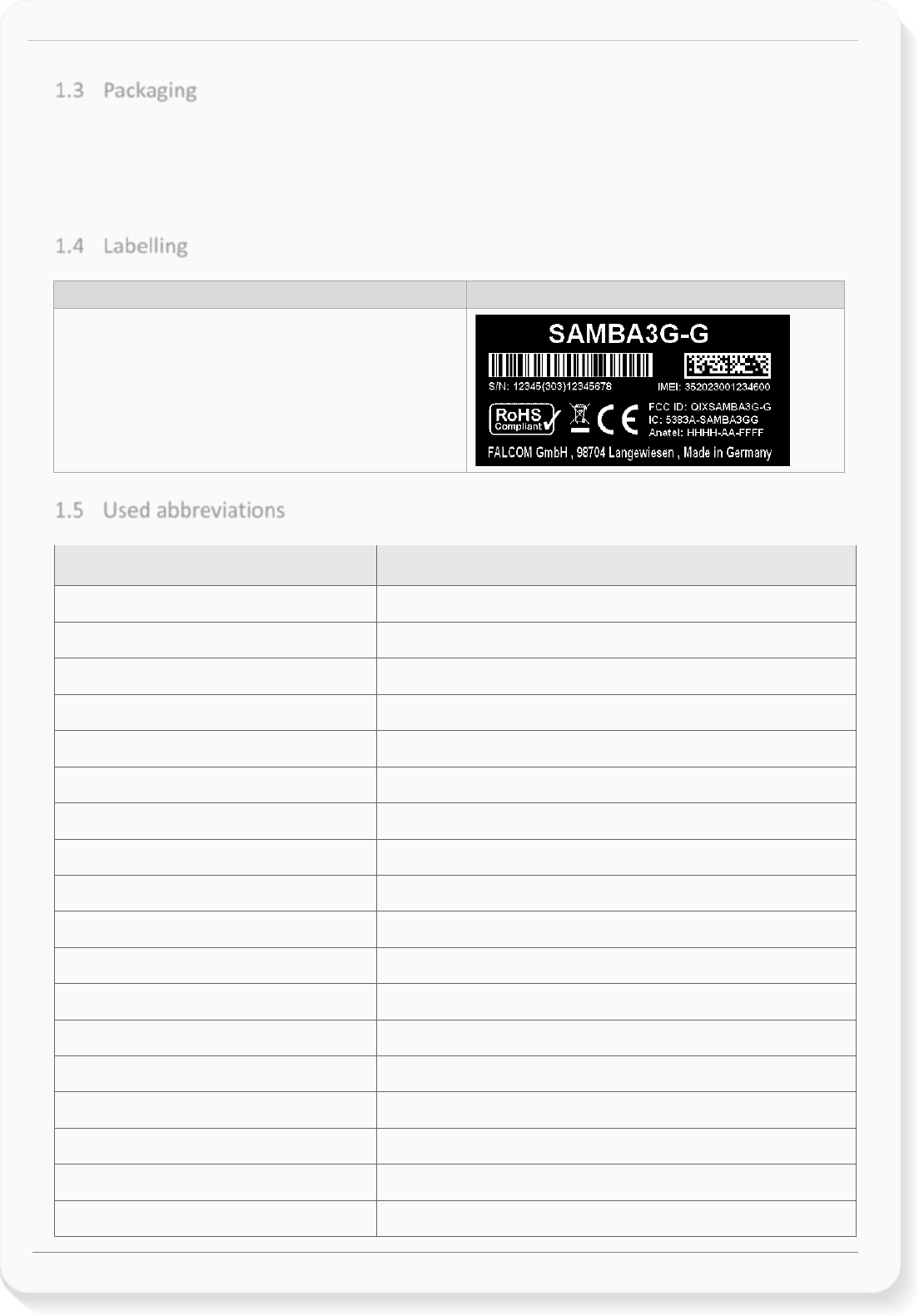
SAMBA3G-G Version 1.0.3
This confidential document is a property of FALCOM GmbH and may not be copied or circulated without previous permission.
Page 6 of 22
1.3 Packaging
SAMBA3G-G is shipped in a 50 pcs bulk carton box
Overall size: 170mm x 120mm x 56mm
• Weight: 2.8 kg
1.4 Labelling
Font label of SAMBA3G-G Back label of SAMBA3G-G
None
1.5 Used abbreviations
Abbreviation Description
ETSI
European Telecommunications Standards Institute
GSM Global System for Mobile communications
IMEI International Mobile station Equipment Identity
ME
Mobile Equipment
EDGE Enhanced Data rates for GSM Evolution
GPRS General Packet Radio Service
GMSK
Gaussian Minimum Shift Keying
UMTS Universal Mobile Telecommunications System
HSDPA
High Speed Downlink Packet Access
HSPA
High Speed Packet Access
PLMN
Public Land Mobile Network
PIN Personal Identification Number
PUK Personal Unblocking Key
RP
Receive Protocol
SIM Subscriber Identity Module
SMS Short Message Service
SMS/PP
Short Message Service/Point-to-Point
TA
Terminal Adapter

SAMBA3G-G Version 1.0.3
This confidential document is a property of FALCOM GmbH and may not be copied or circulated without previous permission.
Page 7 of 22
Abbreviation Description
TE Terminal Equipment
TP Transmit Protocol
MS
Mobile Station
USB
Universal Serial Bus
PTM Point To Multipoint
NOM Network Operation Mode
PPP
Point to Point Protocol
PSK Phase Shift Keying
CSD
Circuit Switched Data
APN
Access Point Naming
IP
Internet Protocol
PDP Packet Data Protocol
RF Radio Frequency
UMTS
Universal Mobile Telecommunications System
HSDPA High-Speed Downlink Packet Access
IC Industry Canada
Table 1: Used abbreviations
1.6 Related documents
[1] 3GPP TS 27.007 - AT command set for User Equipment (UE)
[2] 3GPP TS 27.005 - Use of Data Terminal Equipment - Data Circuit terminating; Equipment (DTE -
DCE) interface for Short Message Service (SMS) and Cell Broadcast Service (CBS)
[3] 3GPP TS 27.010 - Terminal Equipment to User Equipment (TE-UE) multiplexer protocol
[4] u-blox AT Commands Manual, Docu No UBX-13002752
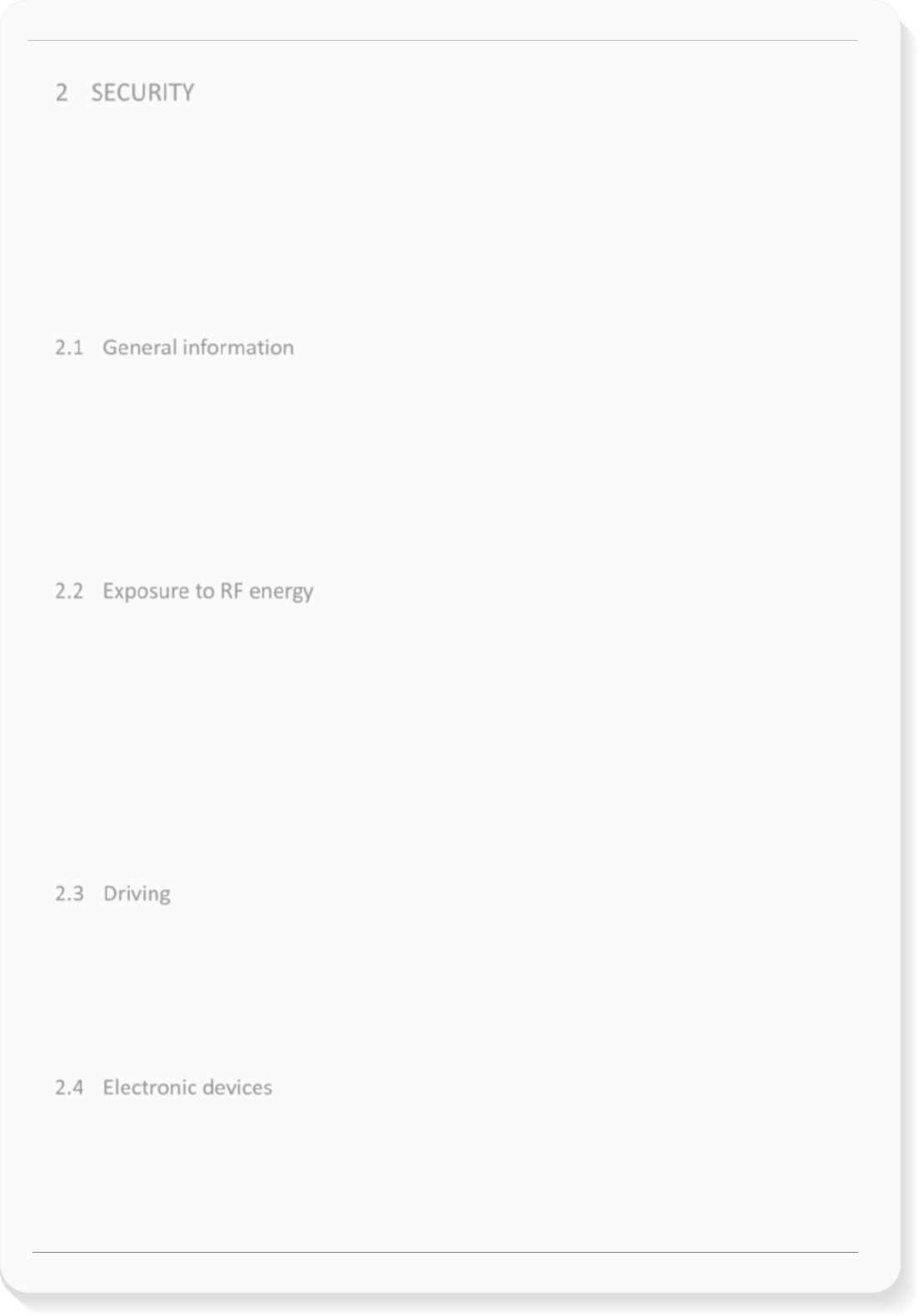
SAMBA3G-G Version 1.0.3
This confidential document is a property of FALCOM GmbH and may not be copied or circulated without previous permission.
Page 8 of 22
2SECURITY
IMPORTANT FOR THE EFFICIENT AND SAFE OPERATION OF YOUR GSM-MODEM, READ THIS
INFORMATION BEFORE USE!
Your cellular engine SAMBA3G-G is one of the most exciting and innovative electronic products
ever developed. With it you can stay in contact with your office, your home, emergency services
and others, wherever service is provided.
This chapter contains important information for the safe and reliable use of the SAMBA3G-G
modem. Please read this chapter carefully before starting to use the cellular engine SAMBA3G.
2.1 General information
Your SAMBA3G-G device utilizes the GSM standard for cellular technology. GSM is a newer radio
frequency („RF“) technology than the current FM technology that has been used for radio
communications for decades. The GSM standard has been established for use in the European
community and elsewhere. Your SAMBA3G-G is actually a low power radio transmitter and
receiver. It sends out and receives radio frequency energy. When you use your modem, the cellular
system handling your calls controls both the radio frequency and the power level of your cellular
modem.
2.2 Exposure to RF energy
There has been some public concern about possible health effects of using a GSM modem.
Although research on health effects from RF energy has focused for many years on the current RF
technology, scientists have begun research regarding newer radio technologies, such as GSM. After
existing research had been reviewed, and after compliance to all applicable safety standards had
been tested, it has been concluded that the product is fit for use.
If you are concerned about exposure to RF energy there are things you can do to minimize
exposure. Obviously, limiting the duration of your calls will reduce your exposure to RF energy. In
addition, you can reduce RF exposure by operating your cellular modem efficiently by following
the guidelines below.
2.3 Driving
Check the laws and regulations on the use of cellular devices in the area where you drive. Always
obey them. Also, when using your modem while driving, please pay full attention to driving, pull
off the road and park before making or answering a data call if driving conditions so require. When
applications are prepared for mobile use they should fulfil road-safety instructions of the current
law!
2.4 Electronic devices
Most electronic equipment, for example in hospitals and motor vehicles is shielded from RF
energy. However, RF energy may affect some malfunctioning or improperly shielded electronic
equipment.
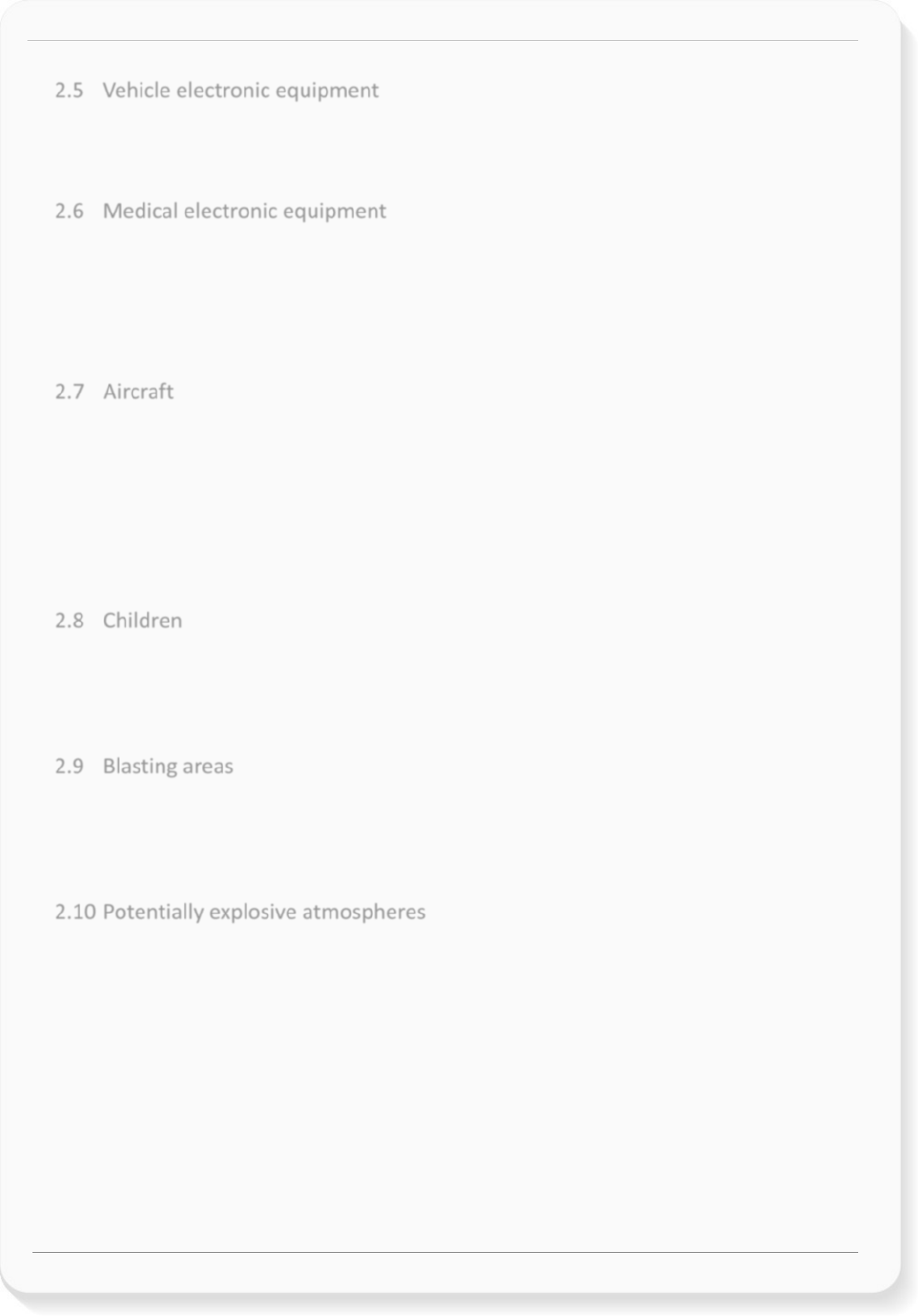
SAMBA3G-G Version 1.0.3
This confidential document is a property of FALCOM GmbH and may not be copied or circulated without previous permission.
Page 9 of 22
2.5 Vehicle electronic equipment
Check your vehicle manufacturer’s representative to determine if any on board electronic
equipment is adequately shielded from RF energy.
2.6 Medical electronic equipment
Consult the manufacturer of any personal medical devices (such as pacemakers, hearing aids, etc.)
to determine if they are adequately shielded from external RF energy.
Turn your SAMBA3G-G device OFF in health care facilities when any regulations posted in the area
instruct you to do so. Hospitals or health care facilities may be using RF monitoring equipment.
2.7 Aircraft
Turn your SAMBA3G-G OFF before boarding any aircraft. Use it on the ground only with crew
permission. Do not use it in the air.
To prevent possible interference with aircraft systems, Federal Aviation Administration (FAA)
regulations require you to have permission from a crew member to use your modem while the
plane is on the ground. To prevent interference with cellular systems, local RF regulations prohibit
using your modem whilst airborne.
2.8 Children
Do not allow children to play with your SAMBA3G-G device. It is not a toy. Children could hurt
themselves or others (by poking themselves or others in the eye with the antenna, for example).
Children could damage the modem or make calls that increase your modem bills.
2.9 Blasting areas
To avoid interfering with blasting operations, turn your unit OFF when in a “blasting area” or in
areas posted: "turn off two-way radio". Construction crew often uses remote control RF devices to
set off explosives.
2.10 Potentially explosive atmospheres
Turn your SAMBA3G-G device OFF when in any area with a potentially explosive atmosphere. It is
rare, but your modems or their accessories could generate sparks. Sparks in such areas could
cause an explosion or fire resulting in bodily injury or even death.
Areas with a potentially explosive atmosphere are often, but not always, clearly marked. They
include fuelling areas such as petrol stations; below decks on boats; fuel or chemical transfer or
storage facilities; and areas where the air contains chemicals or particles, such as grain, dust or
metal powders.
Do not transport or store flammable gas, liquid or explosives, in the compartment of your vehicle,
which contains your modem or accessories.

SAMBA3G-G Version 1.0.3
This confidential document is a property of FALCOM GmbH and may not be copied or circulated without previous permission.
Page 10 of 22
Before using your modem in a vehicle powered by liquefied petroleum gas (such as propane or
butane) ensure that the vehicle complies with the relevant fire and safety regulations of the
country in which the vehicle is to be used.
2.11 Non-ionizing radiation
The SAMBA3G-G comes with an internal antenna. Therefore, care should be taken to install the
modem in such a position that no part of the human body will normally rest within 20 cm of any
part of the modem. It is also recommended to use the modem not close to medical devices as for
example hearing aids and pacemakers.

SAMBA3G-G Version 1.0.3
This confidential document is a property of FALCOM GmbH and may not be copied or circulated without previous permission.
Page 11 of 22
3 SAFETY STANDARDS
Your GSM mobile complies with all applicable RF safety standards.
The GSM mobile meets the safety standards for RF receivers and the standards and
recommendations for the protection of public exposure to RF electromagnetic energy established
by government bodies and professional organizations, such as directives of the European
Community, Directorate General V in matters of radio frequency electromagnetic energy.
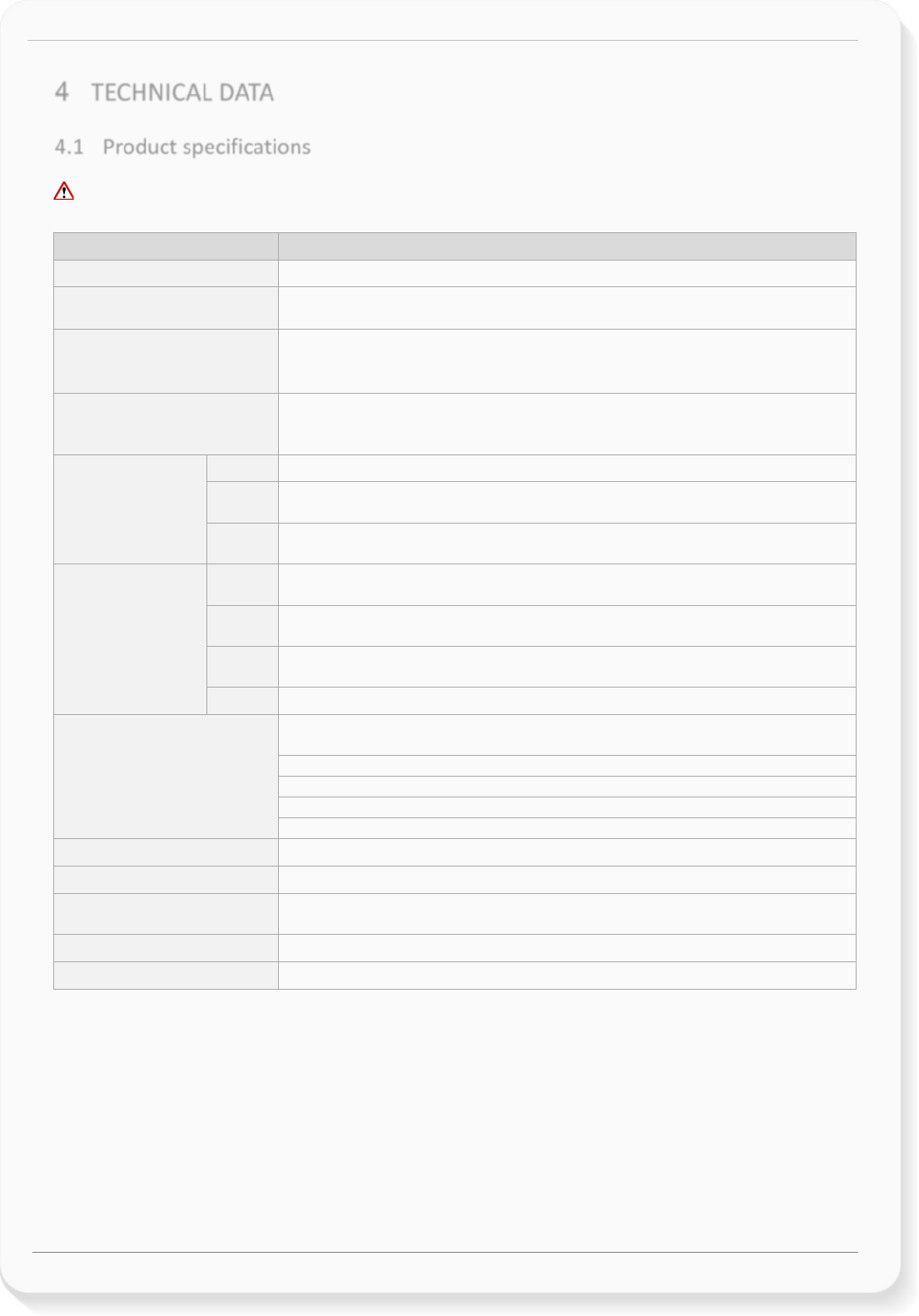
SAMBA3G-G Version 1.0.3
This confidential document is a property of FALCOM GmbH and may not be copied or circulated without previous permission.
Page 12 of 22
4 TECHNICAL DATA
4.1 Product specifications
Operation beyond the operating conditions is not recommended and extended exposure beyond
them may affect device reliability.
FEATURES DESCRIPTION
POWER SUPPLY RANGE +5 VDC through USB port, compliant with USB 2.0 specification
DIMENSIONS
Size: 89mm x 38mm x 13,7mm ±2 (L x B x H)
Weight: 35 g
OPERATING TEMP. RANGE
-40 °C to +85 °C
Normal temperature range*: -20 °C to +65 °C
Storage temperature : -40 °C to +90 °C
Frequency bands
Band I (2100 MHz), Band II (1900 MHz), Band IV (1700 MHz), Band V (850
MHz), Band VI (800 MHz), Band VIII (900 MHz)
Compliant to GSM Phase 2/2+
Transmit power
HSDPA Power Class 3 (24 dBm)
EDGE
Power Class E2 (27 dBm) for GSM/E-GSM bands
Power Class E2 (26 dBm) for DCS/PCS bands
GPRS
Power Class 4 (33 dBm) for GSM/E-GSM bands
Power Class 1 (30 dBm) for DCS/PCS bands
DATA
HSDPA
Data downlink transfer: max. 7.2 Mb/s.
Data uplink transfer: max. 5.76 Mb/s.
EDGE
EDGE data downlink/uplink transfer: max. 236.8 kbps.
Modulation and Coding Scheme: MCS 1 - 9.
GPRS
GPRS multi-slot class 12 , coding scheme CS1-CS4
EDGE multi-slot class 12 , coding scheme MCS1-MCS9
CSD Downlink/Uplink up to 14.4 kbps
Additional features
Embedded TCP/IP and UDP/IP stack including direct link mode for TCP and
UDP sockets
SMS
Standard and extended AT command set
Minimal power consumption
Modem firmware upgradeable via USB or via over-the-air
MMS MMS compliant
FAX Group 3: class 1, class 2
SIM Interface
Slot for small SIM cards 3/1.8 V
Mini-SlM (2FF) according to ISO / IEC 7810: 2003, lD-000
USB COMMUNICATION USB 2.0 Full Speed (12 Mbit/s) slave interface
ANTENNA Internal
* The cellular module is fully functional and meets the 3GPP specification across the specified temperature range.
Table 2: Product specifications

SAMBA3G-G Version 1.0.3
This confidential document is a property of FALCOM GmbH and may not be copied or circulated without previous permission.
Page 13 of 22
Coding scheme 1 Timeslot 2 Timeslots 4 Timeslots
CS-1: 9.05 kbps 18.1 kbps 36.2 kbps
CS-2: 13.4 kbps 26.8 kbps 53.6 kbps
CS-3: 15.6 kbps 31.2 kbps 62.4 kbps
CS-4:
21.4 kbps
42.8 kbps
85.6 kbps
Table 3: GPRS Coding schemes and maximum network data rates over air interface
Please note that the values listed above are the maximum ratings which, in practice, are influenced by a great variety
of factors, primarily, for example, traffic variations and network coverage.
EDGE is four times as efficient as GPRS. GPRS use four coding schemes (CS-1 to 4, see table 3) while EDGE use nine
Modulation and Coding Schemes (MCS-1 to 9, see table 3.1).
Coding and modulation scheme (MCS) Speed Modulation
MCS-1:
8.80 kbit/s/slot
GMSK
MCS-2: 11.2 kbit/s/slot GMSK
MCS-3:
14.8 kbit/s/slot
GMSK
MCS-4: 17.6 kbit/s/slot GMSK
MCS-5: 22.4 kbit/s/slot 8-PSK
MCS-6:
29.6 kbit/s/slot
8-PSK
MCS-7: 44.8 kbit/s/slot 8-PSK
MCS-8:
54.4 kbit/s/slot
8-PSK
MCS-9: 59.2 kbit/s/slot 8-PSK
Table 3.1: EDGE Coding schemes
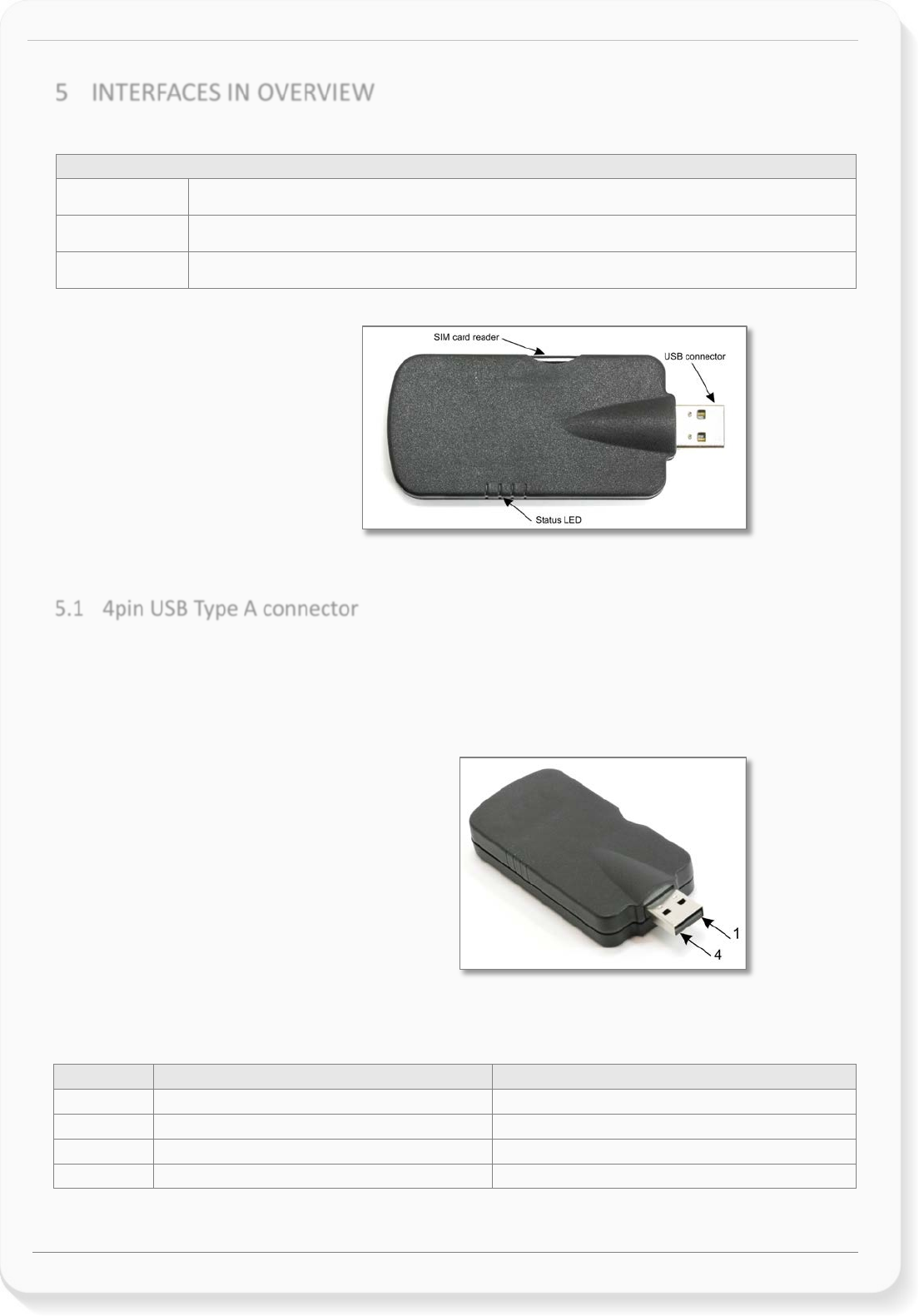
SAMBA3G-G Version 1.0.3
This confidential document is a property of FALCOM GmbH and may not be copied or circulated without previous permission.
Page 14 of 22
5INTERFACES IN OVERVIEW
The table below lists all interfaces available on the SAMBA3G-G modem:
Interface specifications
USB
USB A-type plug connector is used to connect the modem to a USB host.
LED
Used to show the status of the modem.
SIM
SIM card reader for small SIM cards (3/1.8V).
Table 4: Modem interfaces
Figure 1: View of SAMBA3G-G interfaces.
5.1 4pin USB Type A connector
The physical interface to the modem application is made through the USB connector which
simplifies setup and operation of the modem. It allows direct connection to a USB host port and it
gives you maximum life from your laptop's battery in that it draws power directly from the USB
port and only uses the battery when plugged in.
Figure 2: Pinout of the USB connector
The following table lists the pin configuration of the USB connector on the SAMBA3G-G, viewed
from face of plug.
PIN
NAME
DESCRIPTION
1
VCC
+ 5V
2
D -
Data -
3
D +
Data +
4
GND
Ground
Table 5: Pinout of the USB connector on the SAMABA3G modem
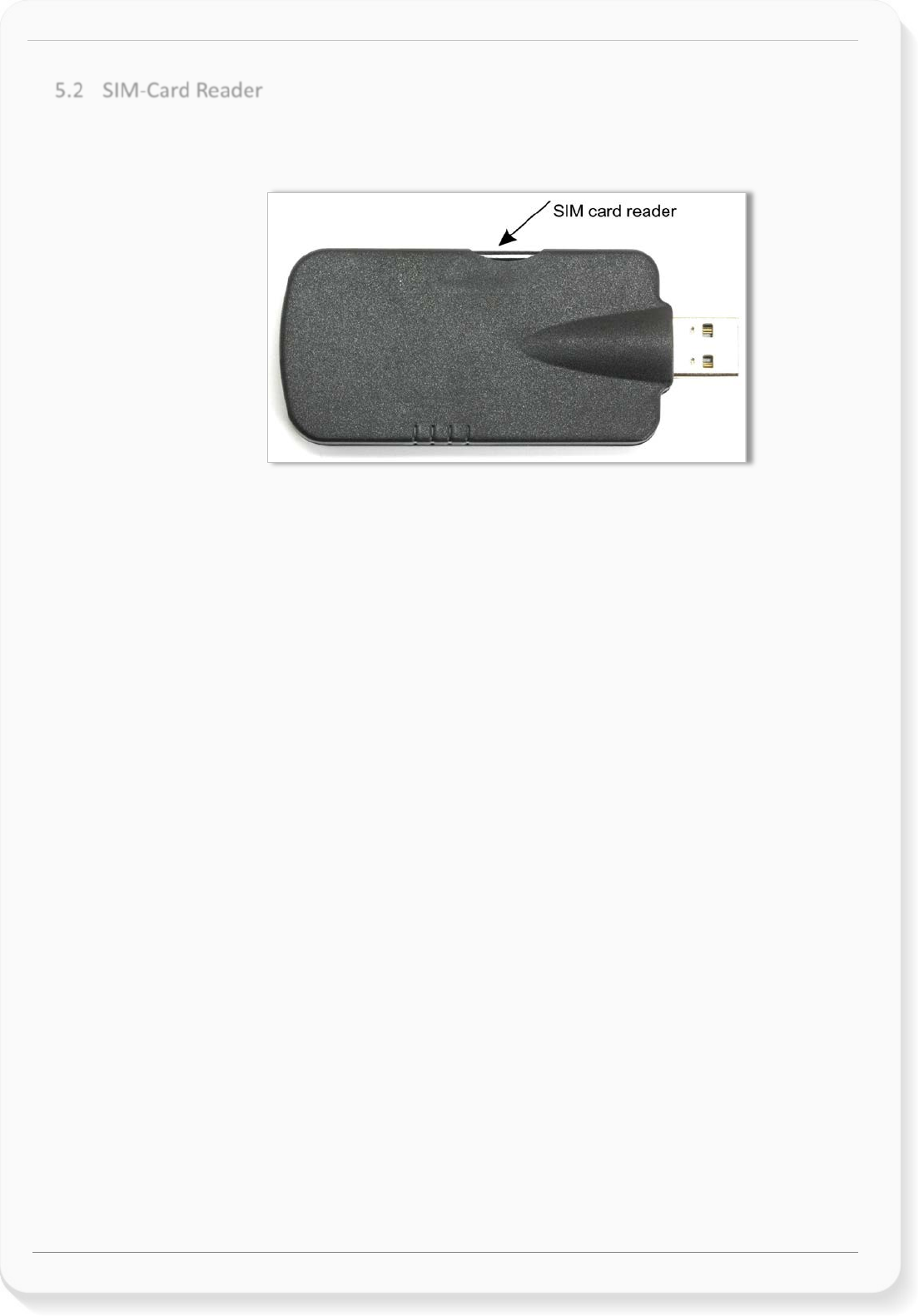
SAMBA3G-G Version 1.0.3
This confidential document is a property of FALCOM GmbH and may not be copied or circulated without previous permission.
Page 15 of 22
5.2 SIM-Card Reader
The SIM interface controls 3 and 1.8V SIM cards. This interface is fully compliant with GSM 11.11
recommendations concerning SIM functions.
Figure 4: SIM Card interface
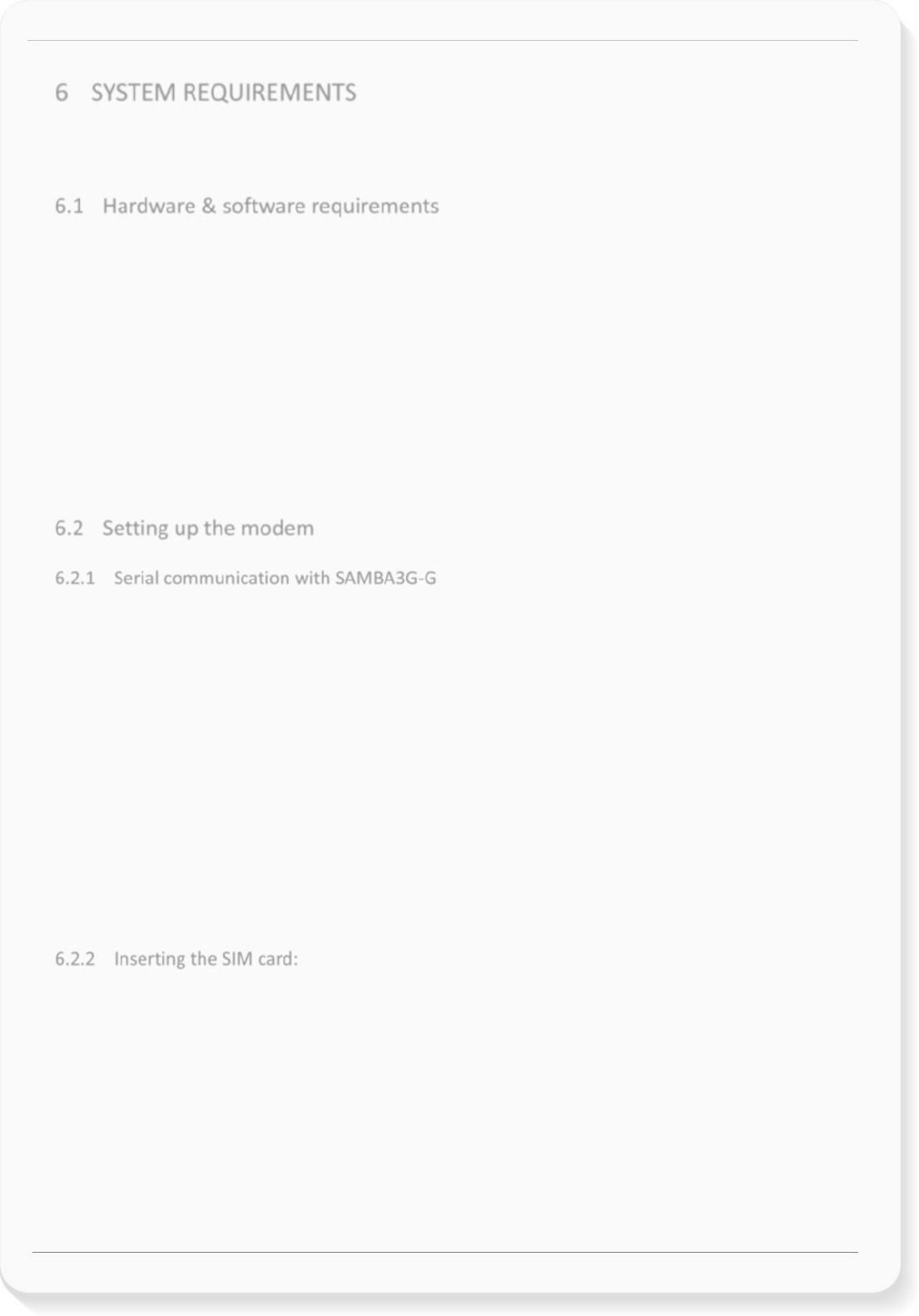
SAMBA3G-G Version 1.0.3
This confidential document is a property of FALCOM GmbH and may not be copied or circulated without previous permission.
Page 16 of 22
6SYSTEM REQUIREMENTS
Check your hardware and software and see if they satisfy the requirements below. If you are not
sure, please consult your vendor or operator.
6.1 Hardware & software requirements
Hardware & software requirements
A valid SIM card (with GPRS/3G enabled).
1 x Free compatible USB port
Approximately 6 Mb of free hard disk space.
Pentium 90 or higher.
Operating systems: Windows® XP (32bit), Vista (32bit), 7 (32bit) & (64bit), 10 (32bit) & (64bit)
CD-ROM drive.
For data applications, you need.
Browser and email client
6.2 Setting up the modem
6.2.1 Serial communication with SAMBA3G-G
SAMBA3G-G modem includes a high-speed USB 2.0 compliant interface with maximum 480 Mb/s
data rate. The modem itself acts as a USB device and can be connected to any USB host. The USB is
the suitable interface for transferring high speed data between SAMBA3G-G modem and a host
processor, available for AT commands, data communication and for diagnostic purposes. The
USB_D+ / USB_D- lines carry the USB serial data and signalling.
USB drivers are available for the following operating system platforms:
Windows XP (32bit)
Windows Vista (32bit)
Windows 7 (32bit) & (64bit)
Windows 10 (32bit) & (64bit)
This chapter describes how to install your SAMBA3G-G in Windows. It is recommended that all-
important files in your computer are backed up before the installation.
6.2.2 Inserting the SIM card:
SAMBA3G-G requires a small SIM card, which is provided by your mobile phone service provider.
This contains the telephone number of SAMBA3G-G will use, as well as other customer
information. To use UMTS services the SIM card should be UMTS-enabled.
1) Insert a SIM card:
Insert the SIM card into the corresponding SIM card reader of the modem as shown in
figure below and slide it forward until it stops. The bevelled corner of the SIM card has to
be on the left side of SIM card reader and the golden contact area is facing downwards.
Make sure that the SIM card is sit firmly into the SIM card reader slot. See also figures
below.
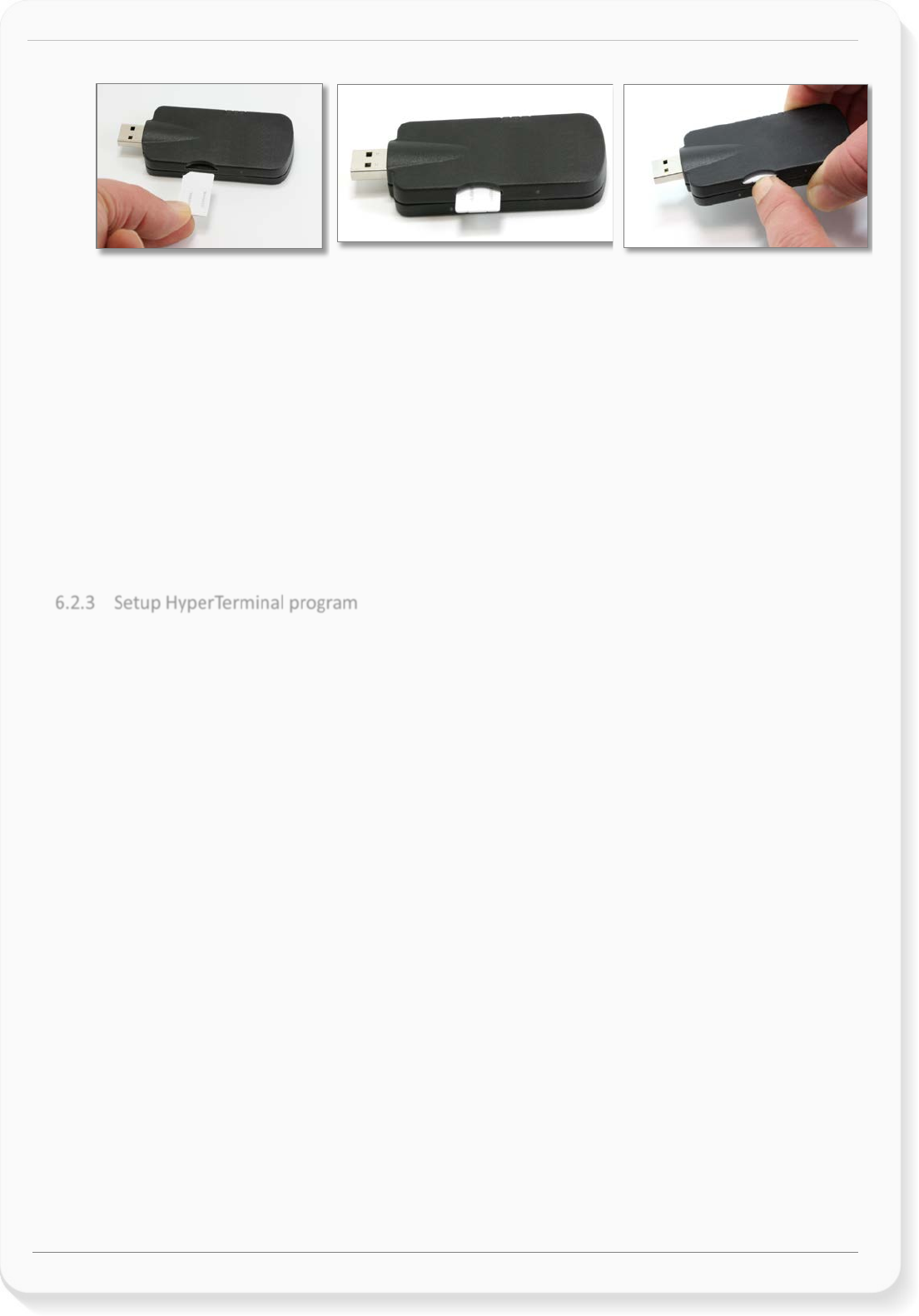
SAMBA3G-G Version 1.0.3
This confidential document is a property of FALCOM GmbH and may not be copied or circulated without previous permission.
Page 17 of 22
Figure 5.a: Insert the SIM
Card.
Figure 5.b: Push it forward into
the SIM-holder until it
stops.
Figure 5.c: To remove the SIM,
press the edge of
card using your
finger nail or a
pointed object.
2) Remove the SIM card:
To remove the SIM card, just press the inserted SIM card by using your finger nail or a
pointed object. The SIM card will jump out when you release it. Finally, take it out.
Important: Do not insert or remove the SIM card when the device is under power.
Keep all miniature SIM cards out small children’s reach. The SIM card and its
contacts can be damaged by scratches or bending, so be careful when handling,
inserting or removing the SIM card.
6.2.3 Setup HyperTerminal program
To communicate with the SAMBA3G-G modem, start the HyperTerminal program or another
terminal program, and then use the AT commands available in the corresponding manual.
To start the HyperTerminal go to:
START – PROGRAMS – ACCESSORIES –COMMUNICATION – HYPERTERMINAL, then start
the software HyperTerminal, assign the name of your choice (e.g. SAMBA3G-G), click on
the icon of your choice, then click OK. On the appeared dialog box choose:
Connect using, e.g. COM3 (COM port assigned to "SAMAB3G-G")
Then click on OK. On the properties of the selected COM port choose:
Properties, choose 115200 bps – 8 bits data – no parity – 1 stop bit – hardware flow
control
Finally click on OK.
Once HyperTerminal or other terminal program is opened and configured (see Fig. 11), use AT
commands to perform your specific settings.
To test the SAMBA3G-G modem type on the terminal screen:
AT<enter>
Modem responds:
OK
If you don't see the characters you are typing, enter ATE1 and then press Enter key.
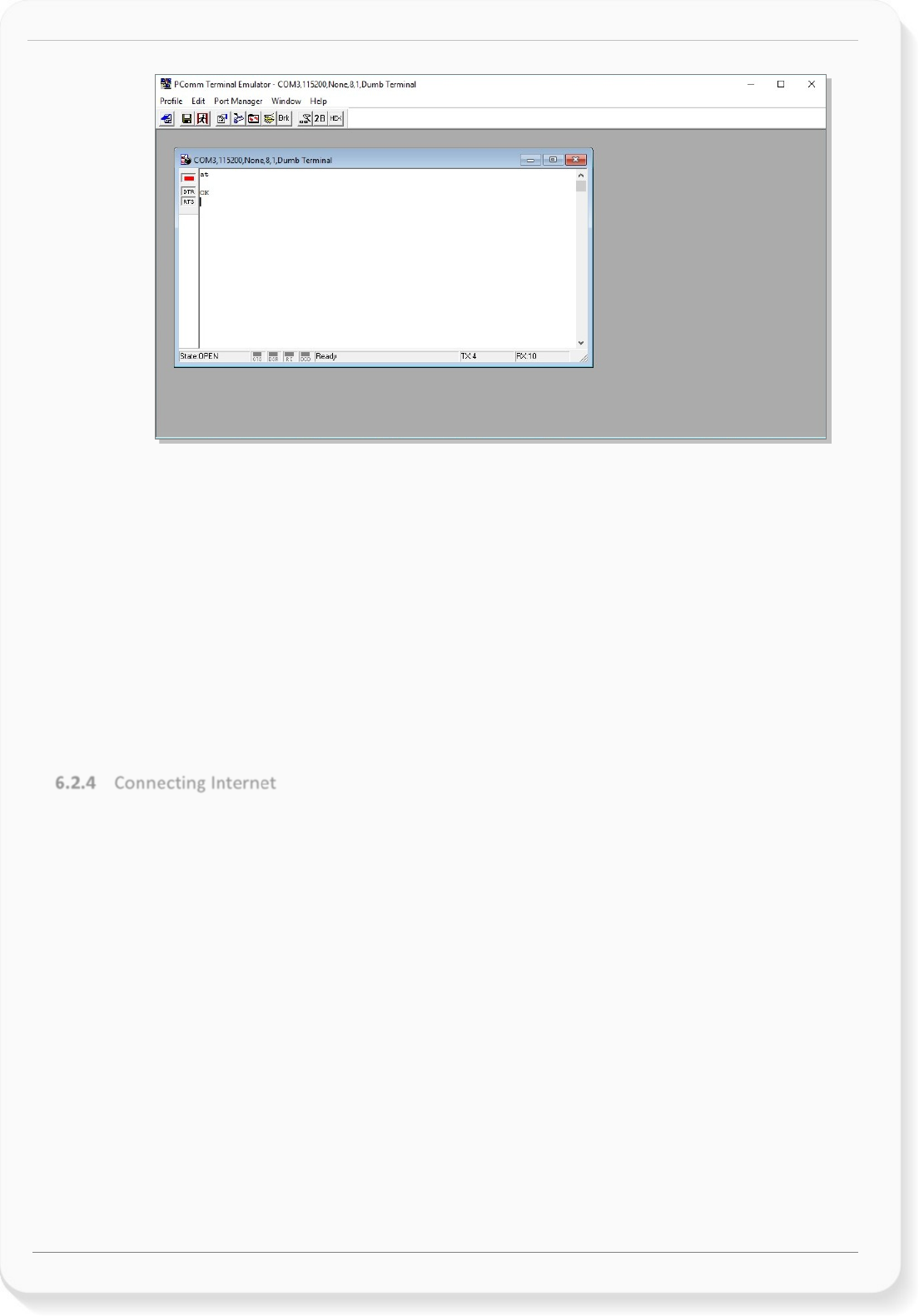
SAMBA3G-G Version 1.0.3
This confidential document is a property of FALCOM GmbH and may not be copied or circulated without previous permission.
Page 18 of 22
Figure 11: PComm terminal screen.
To enter the PIN code of the used SIM card type on the terminal screen:
AT+CPIN=pin<enter> // pin = PIN code of your SIM card
Modem responds:
OK
The SAMBA3G-G will go into the search mode and the Status LED will operate as described in Table
6.
The SAMBA-3G-G has inside a parser function that converts some of Telit G864 AT commands to u-
blox AT Commands. Please contact FALCOM for more detailed information about the list of Telit
G864 AT commands which are then internally parsed into u-blox AT Commands.
6.2.4 Connecting Internet
For more information how to connect the modem to the internet using GPRS or 3G settings and
TCP settings, please refer to the u-blox AT Commands Manual [4].
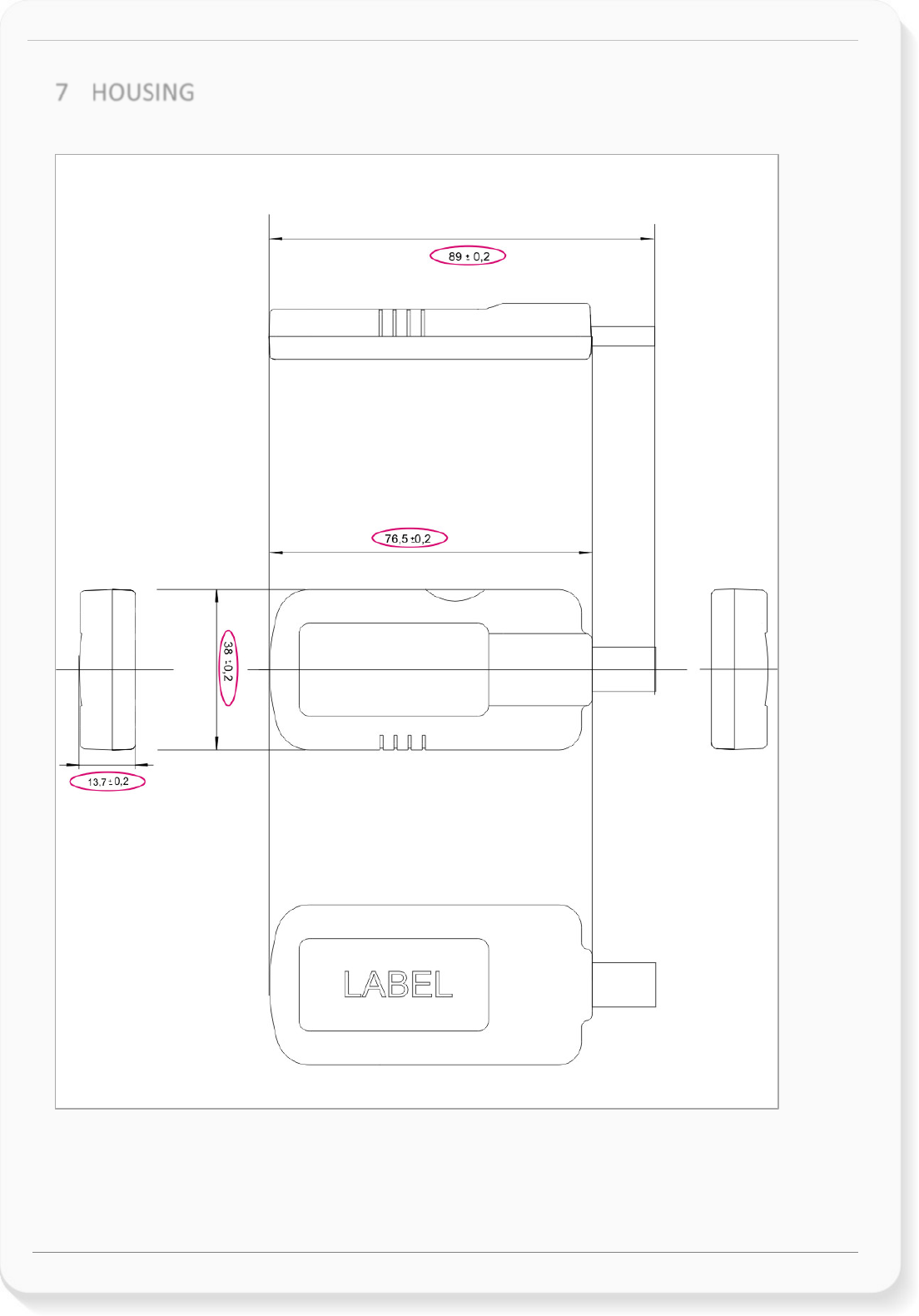
SAMBA3G-G Version 1.0.3
This confidential document is a property of FALCOM GmbH and may not be copied or circulated without previous permission.
Page 19 of 22
7HOUSING
The necessary dimensions for the housing can be found in the drawing below.

SAMBA3G-G Version 1.0.3
This confidential document is a property of FALCOM GmbH and may not be copied or circulated without previous permission.
Page 20 of 22
8 RF EXPOSURES
8.1 FCC and IC Statement (USA and Canada) - English
This device contains 850/900/1900 MHz GSM/GPRS functions and 800/850/900/1700/2100 MHz
UMTS functions and is operational in these frequencies, respectively.
Following frequency bands are not operational (must not be used) in U.S. Territories.
• GSM: 900 MHz
• UMTS: 800/900/2100 MHz
The external antennas used for this portable application must provide a separation distance of at
least 0 cm from all persons and must not be co-located or operating in conjunction with any other
antenna or transmitter.
FCC Statement for USA:
This device complies with Part 15 of the FCC Rules. Operation is subject to the following two
conditions:
(1) This device may not cause interference; and
(2) This device must accept any interference, including interference that may cause undesired
operation of the device.
Statement according to FCC part 15.21:
Modifications not expressly approved by this company could void the user's authority to operate
the equipment.
Statement according to FCC part 15.105:
NOTE: This equipment has been tested and found to comply with the limits for a Class B digital
device, pursuant to Part 15 of the FCC Rules. These limits are designed to provide reasonable
protection against harmful interference in a residential installation. This equipment generates,
uses and can radiate radio frequency energy and, if not installed and used in accordance with the
instructions, may cause harmful interference to radio communications.
However, there is no guarantee that interference will not occur in a particular installation. If this
equipment does cause harmful interference to radio or television reception, which can be
determined by turning the equipment off and on, the user is encouraged to try to correct the
interference by one or more of the following measures:
• Reorient or relocate the receiving antenna.
• Increase the separation between the equipment and receiver.
• Connect the equipment into an outlet on a circuit different from that to which the receiver
is connected.
• Consult the dealer or an experienced radio/TV technician for help.

SAMBA3G-G Version 1.0.3
This confidential document is a property of FALCOM GmbH and may not be copied or circulated without previous permission.
Page 21 of 22
IC Statement for Canada
This device complies with Industry Canada’s licence-exempt RSSs. Operation is subject to the
following two conditions:
(1) This device may not cause interference; and
(2) This device must accept any interference, including interference that may cause undesired
operation of the device.
8.2 Déclaration FCC et IC (USA at Canada) - French
Cet appareil contient des fonctions 850/900/1900 MHz GSM/GPRS et 800/850/900/1700/2100
MHz UMTS et est opérationnel dans ces fréquences, respectivement.
Les bandes de fréquences suivantes ne sont pas opérationelles (ne doivent pas être utilisés) dans
le térritoire fédéral américain:
GSM: 900 MHz
UMTS: 800/900/2100 MHz
L'antenne externe utilisé pour cette application portable doit être plaçée à une distance d'au
moins 0 cms de toute personne et ne doit pas être placée ou manié en combinaison avec nulle
autre antenne ou transmetteur..
Déclaration FCC partie pur USA:
Cet appareil satisfait aux règles de la FCC, partie 15. La mise en service est sujette aux deux
conditions suivantes:
(1) cet appareil ne doit pas causer d'interférences préjudiciables et
(2) cet appareil doit accepter toute interférence reçue, interférences, qui peuvent causer des
actions indésirés, inclues.
Déclaration en accord avec FCC partie 15.21:
Des modifications n'ayant pas été expressément approuvé par cette société, pourraient anuller
l'authorisation de l'utilisateur d'opérer cet équipement.
Déclaration en accord avec FCC partie15.105:
NOTE: Cet équipment a été testé et satisfait aux limites d'un appareil digital, classe B, en accord
avec la partie 15 des règles de la FCC. Ces limitations sont détérminés pour assurer une protection
raisonable contre les interférences préjudiciables lors d'une installation résidentielle. Cet appareil
génère, utilise et peux répandre de l'énergie radiofréquence et, s'il n'est pas installé et utilisé en
accord avec les instructions, peux causer des interférences préjudiciables à la radiocommunication.
Cependant, il n'y a pas de garantie que des interférences n'auront pas lieu dans une installation
particulière. Çi l'équipement pose des interférences préjudiciables à la réception radio ou
télévision, ce qui peut être déterminé en allumant et éteignant l'équipement, l'utilisateur est
encouragé à essayer de rectifier les interférences par l'une au l'autre des mesures suivantes:

SAMBA3G-G Version 1.0.3
This confidential document is a property of FALCOM GmbH and may not be copied or circulated without previous permission.
Page 22 of 22
Réorientez ou relocalisez l'antenne réceptrice.
Augmentez la distance entre l'équipement et le récepteur.
Connectez l'équipment à une prise dans un circuit different de celui auquel le récepteur est
connecté.
Consultez votre revendeur ou in téchnicien radio/télévision expérimenté pour du support.
Déclaration Industrie Canada
Le présent appareil est conforme aux CNR d’Industrie Canada applicables aux appareils radio
exempts de licence. L’exploitation est autorisée aux deux conditions suivantes:
(1) l’appareil ne doit pas produire de brouillage;
(2) l’appareil doit accepter tout brouillage radioélectrique subi, même si le brouillage est
susceptible d’en compromettre le fonctionnement.